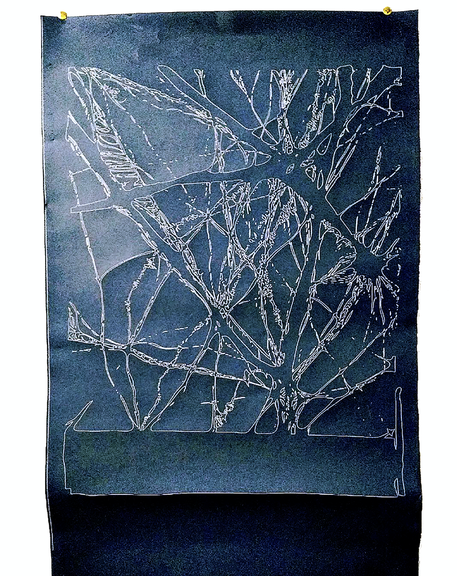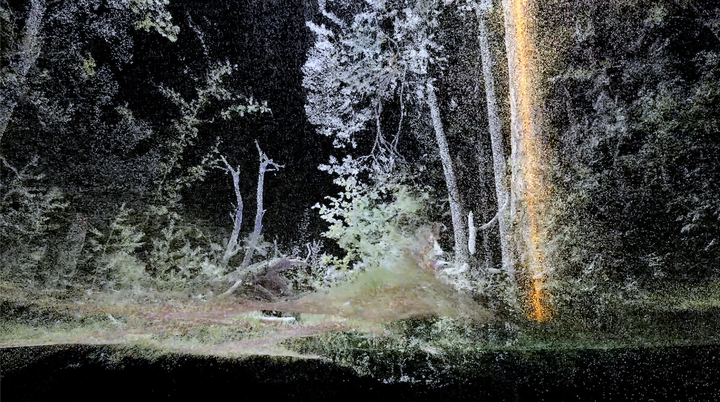Issue 1/2023 - Zuhören
“Emancipatory Listening Is Not Singular, But Collective”
About Vibrational Practices, Listening Cultures, Trees and Affects
The kind of listening – to voices, to sounds, to music – that I learned from day one positioned me as a singular individual, listening alone in a big world.
“Did you hear what I said?”
“Why are you ignoring me when I’m talking to you?”
“No, no, you misheard me.”
“Can you please listen to this and double-check my transcription?”
“I heard it firsthand; you only heard it secondhand.”
“Did you hear a woman or a man in the background of that call?”
“Transcribe this melody [or rhythm, or harmonic progression].”
“Identify these instruments.”
“Can you tell if you are you in or out of tune now?”
The listening culture I was brought up in imagines each listener as a little isolated island, and this island is tested by each act of listening.1 Each time, the test asks whether a person is hearing correctly or incorrectly, whether they are right or wrong, whether they are informed or uninformed. Each act of listening, then, is set up to judge whether a person is a good or poor listener. If listening were an equation, the “good” or “poor” designation would point back to a single individual.
“Go wash your ears so you can hear better!”
In the listening practice that formed me, individual ears are at the center.
Question to every two-year-old: “What do we hear with?”
Considered correct response by every two-year-old: “My ears!” – while grabbing their two ears.
In its epistemology, sound studies has critiqued the primacy of vision in imagining the world. The centering of aurality-based hearing and experiencing music (my field) is critiqued by disability, crip, and sensory studies.2 I have absorbed these shifts, and also want to burrow into this small point: even in these mindful critiques, listening or sensing is assumed to take place at the point of an individual person’s auditory or sensory system, whether that system is then defended or expanded.
As elsewhere, emancipation in the realm of listening is not singular, but collective. But what does that mean when we consider listening? Emancipatory listening is not about getting people to hear “this way” instead of “that way.” It is not about individuals demonstrating non-discriminatory instead of discriminatory listening – that is, it is not about getting people to hear what is currently the “correct” thing.
In fact, I argue that insofar as we locate discriminatory listening as an error in individuals’ listening – as much woke and call-out culture does – we are using the wrong map and will not find our way.
Let us take a step back. As a vocalist and musicologist, I have studied and documented structural racism as it manifests in listening and vocal culture. My work has focused on showing how, in a given society where race matters, not only facial features, skin color and hair color and texture, but also voices are racialized. For example, many classical voice teachers imagine that they hear a connection between students’ “unique and individual” voices and their race or ethnicity and, as a consequence, teach that very sound through the weekly lessons that professional classical singers undergo for a minimum of a decade. The voice teacher listens to the student’s voice, makes an assessment, and offers technical (and stylistic and so on) instructions. A large part of absorbing this training involves the student taking on their teacher’s way of listening – a necessity in order to be able to hear themselves in relation to an achievable goal, and to make the same assessments and corrections that the teacher would. In a successful case – after a long process of repeated feedback, rejection, and affirmation – the teacher’s sensorium is ported into the student, and they are connected within the same listening culture.
During this continuous process of listening and adjustment, the student’s vocal apparatus, ligaments and muscles are trained to automate a certain vocal timbre, which then sounds and feels like simply that person’s voice. Exposing this process of entrainment debunks the myth that voice generally, and vocal timbre specifically, is the sound of an unmediated essence – confirming, say, a person’s race. Thus, if what is heard is recognized as a particular race, gender, or ethnicity, we can now understand that what we hear is something more akin to genre: something that is not inevitable, but is the result of a cultural affinity process that is entrained according to a collective understanding of how a particular group sounds. Both the vocal sound and the understanding of the vocal sound make up a collective cultural understanding and process, rather than an expression of individual essence.3 Case in point: to my Norwegian speaking mom, “British English” and “American English” are vocal categories she is aware of. As a non-English speaker, she is not a member of cultural knowledge groups that parse out Black British or American vocal categories. Therefore, she is not more or less correct when she does not hear vocal Blackness, only vocal Britishness and Americanness.4
However abhorrent any given teacher’s imagined connection between race, ethnicity and vocal uniqueness might seem, their assessment would make no sense if it was conceived in isolation or unique to that teacher. Whatever a person purports to hear is collectively controlled. If the collective does not also hear it, the listener will be considered wrong or uninformed, or could even be diagnosed as “disordered”. Therefore, each assessment that is not labeled wrong, uninformed or disordered constitutes a collective affirmation, sanctioned by an interconnected collective. Individuals’ ears do not function in isolation, but always hear together; this is what gives each singular assessment of a sound or voice an immediate sense of being correct or incorrect.
I would like to propose a comparative image between trees and ears. Walking in a forest, we notice individual trees. We could take it upon ourselves to count and consider each individual tree in a particular area. Knowledge that has been primary to indigenous epistemologies where everything is interconnected and plant biologists who study forests have in the last few years been written quite a lot about in popular science and culture media outlets.
Forest ecologist Suzanne Simard tells us that, even across species, trees are interconnected over great distances via tree and fungi mycorrhiza partnerships.5 And beyond trees, recent research also suggests that mycorrhizal networks permeate and facilitate communication and interconnectedness across prairies, grasslands, chaparral, and Arctic tundra.6 This communication takes the form of carbon, water, nutrients, alarm signals and hormones passing from tree to tree through these subterranean circuits. Says Simard: “I was taught that you have a tree and it’s out there to find its own way… it’s not how a forest works, though.7 In other words, while, from above the earth, what appears as an individual expression or interface with the world – a tree – is always already interconnected via communicative pathways traversing the soil. That particular node reads the world as an interconnected being.
In order to deconstruct the racialization that goes into the process of identifying voices based on race, I had to question the unflinching belief in the stability of sound and voice embedded in the Western musical framework (by this I mean the framework of staff notation, the diatonic scale, and harmony and related concepts).8 I did so by foregrounding the material dimension of sound, singing, and listening. While we know that sound is energy transmitted through a material entity – for example, ligament, eardrum, metal, wood, water, air – within the Western music-theoretical framework sound is treated as a stable, knowable entity. However, as sound is constituted by particular moments when energy and material come together, this cannot be true. To correct it, I have defined singing and listening as intermaterial vibrational practices. This approach offered a similar move away from the assumed individual to the interconnected9 – from a stable, knowable sound that can be identified to an always-unfolding event, and from sonified essence to entrained cultural categories.
If any material entity – including flesh, bone, ligament, teeth, air, wood, metal, gut strings, horsehair bows, or water – is a potential transducer of such an energy transference and intermaterial vibrational event, the so-called same energy is expressed uniquely through each of these materials. For example, sound moves five times faster in water than in air, and the human listening apparatus interacts radically differently when sound is transmitted via water versus air (via skull bone to the inner ear versus via eardrum to the inner ear).10 Therefore, the so-called same energy will be expressed uniquely in a given material and can therefore never be the same.
When thinking about such co-creating relationships through affect and emotion theory, I find Sara Ahmed’s and Teresa Brennan’s formulation helpful. They have suggested that affects and emotions are neither expressed from the “inside out” nor transmitted from the “outside in.” Instead, emotions may be a state found within the social atmosphere.11 And in Ranjana Khanna’s thinking, affect is an opening onto the other, both “within” the self and beyond it.12 Because of this, affect’s definition cannot be known a priori. When humans are involved in this chain of intermaterial vibrational events – when we participate in this practice – definitions neither go from the “inside out” nor come from the “outside in,” but are co-created in a unique occurrence, unrepeatable, unfixed to a single name, but welcoming only multiplicity standing side by side.
Some liberation work, and certainly much of such work in my field, music, begins from a place of trying to right wrongs. This often involves paying attention to music that has been marginalized, ignored, misunderstood or misrepresented, and celebrating and understanding that music. In the process, fingers are pointed and individuals and groups of people are understood to commit violence. The history and presence of violence and erasure is ever so present. However, the process of calling out of individual people and groups is predicated on the same false listening model, that individuals are hearing correctly or incorrectly – whether they are right or wrong, whether they are informed or uninformed.
This model clearly not working. It is not working because it does not capture the process of listening. To understand more about the process of listening, I propose we look to trees and to the process of affect.
Like trees and like affect, emancipatory listening cannot take place on the singular level. It is not a unidirectional pointed finger, but must be effected collectively.
So, rather than calling out individuals for their discriminatory listening – using the individualized model of listeners as right or wrong, and producing defensive reactions and retrenchments – I am putting my own energies into considering the underlying tissue that orients each individual listener’s logic. I am trying to understand that this, in effect, is a listening culture.
In my current work, I focus on one aspect of what makes up the mycorrhizal network connecting listeners: the underlying metaphorical logic of a music and its attendant listening culture.13 This underlying metaphorical logic acts as a root system to connect individual listeners. As each act of listening is part of the process of becoming known in the world, no one person is a unique creative listener, but what they hear is limited to what makes sense within their community of listeners. This is not to abdicate individual responsibility, but simply to note that the job is much bigger and deeper than individualized correctives and therefore we must shift our attention to the subterranean plane with which we are all in vibrational contact.
1 Even though I am not from a family of musicians, the general listening culture (in Norway) I was brought up in was predicated on tonality, harmony, and a grid like logic when it comes to the sense of time. It was predicated on a Work-like ontology of music. Lydia Goehr has described this succinctly in The Imaginary Museum of Musical Works: An Essay in the Philosophy of Music (Oxford University Press, 2007).
2 See, for example, Jonathan Sterne’s now classic audiovisual litany, The Audible Past: Cultural Origins of Sound Reproduction (Duke University Press, 2003), 15.
3 To read the full complex research and argument, see Nina Sun Eidsheim, The Race of Sound: Listening, Timbre, and Vocality in African American Music (Duke University Press, 2019).
4 This is not to say she does not hear other vocal categories she is aware of, such as regionality, one of the most important categories in Norway.
5 Suzanne Simard, Finding the Mother Tree: Discovering the Wisdom of the Forest (Knopf, 2021).
6 Suzanne W. Simard et al., “Mycorrhizal networks: Mechanisms, ecology and modelling,” in: Fungal Biology Reviews 26 (2012) 39-60.
7 Ferris Jabr, “The Social Life of Forests,” in: The New York Times Magazine, December 2, 2020, https://www.nytimes.com/interactive/2020/12/02/magazine/tree-communication-mycorrhiza.html
8 Music theorist Philip Ewell argues that in music discourse “the West” is a metaphor for whiteness (“Musical Metaphor as Racial Structure,” The American Musicological Society Annual Meeting, New Orleans, 10–13 November 2022).
9 See Nina Sun Eidsheim, Sensing Sound: Singing and Listening as Vibrational Practice (Duke University Press, 2015).
10 Read about underwater opera and the way we hear under water in Sensing Sound, 1–57.
11 Sara Ahmed, The Cultural Politics of Emotion (Routledge, 2004); Teresa Brennan, The Transmission of Affect (Ithaca, NY: Cornell University Press, 2004).
12 Ranjana Khanna, “Touching, Unbelonging, and the Absence of Affect,” in: Feminist Theory, 13.2 (2012), 213–232.
13 Nina Sun Eidsheim with Daniel Walden, “Response to Symposium: No Conclusions,” in: Kalfou: A Journal of Comparative and Relational Ethnic Studies 9.2 (2022), 353–371.
Nina Sun Eidsheim has written books about voice, race, and materiality and is Professor of Musicology at the University of California, Los Angeles. She is also a vocalist and the founder and director of the UCLA Practice-based Experimental Epistemology Research (PEER) Lab, an experimental research Lab dedicated to decolonializing data, methodology, and analysis, in and through multisensory creative practices.




